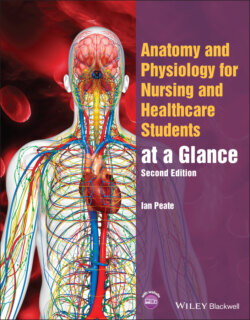Читать книгу Anatomy and Physiology for Nursing and Healthcare Students at a Glance - Ian Peate - Страница 14
Оглавление2 Genetics and genomics
Figure 2.1 DNA and RNA.
Table 2.1 Types of RNA.
| Type of RNA | Description |
|---|---|
| Messenger RNA (mRNA) | Copies portions of genetic code, a process known as transcription, and transports these copies to ribosomes, the cellular factories that facilitate the production of proteins from this code |
| Transfer RNA (tRNA) | Responsible for bringing amino acids, basic protein building blocks, to these protein factories, in response to the coded instructions introduced by the mRNA. This protein‐building process is called translation |
| Ribosomal RNA (rRNA) | The protein builder of the cell, without which protein production would not occur |
Figure 2.2 Mitosis.
Figure 2.3 Meiosis.
Figure 2.4 Fertilisation.
Genetics is the study of the way particular features or diseases are inherited through genes passed down from one generation to the next. The idea of having a single gene for this or a single gene for that (determining fate) is not a good way of describing the complexity of genes. There are groups of genes that work together, influenced by a variety of environmental and other factors. The genome can be seen as the body’s instruction manual, with a copy of it in almost every healthy cell in the body. The study of the genome and the technologies that are required to analyse and interpret it is known as genomics.
DNA and RNA
Both deoxyribonucleic acid (DNA) and ribonucleic acid (RNA) are made of nucleotides (bases) which are the building blocks, responsible for the storage and reading of genetic information that underpins all life. DNA encodes all genetic information, also acting as a biological store allowing the blueprint of life to be passed between generations. RNA reads and then decodes what is stored. This is a multistep process with specialised RNAs for each step (Table 2.1).
DNA and RNA are nucleic acids, known as linear polymers, consisting of sugars, phosphates and bases, but there are differences between the two. The differences permit the two molecules to work together, fulfilling essential roles. See Figure 2.1 for the differences. The complementary base pairs in DNA are adenine (‘A’), thymine (‘T’), guanine (‘G’) and cytosine (‘C’) and RNA shares adenine (‘A’), guanine (‘G’) and cytosine (‘C’) with DNA, but contains uracil (‘U’) instead of thymine (Figure 2.1).
Molecules in DNA have an even and uniform shape while in RNA they are uneven and diverse shapes. DNA molecules are made up of millions of nucleotides and RNA molecules are usually smaller, composed of hundreds to a few thousand nucleotides.
Mitosis, meiosis and fertilisation
The human cell usually has 46 chromosomes: 44 autosomes, which are paired, and two sex chromosomes, usually specifying whether someone is male (usually XY) or female (usually XX). Autosomes, known as homologous chromosomes, have all of the same genes arranged in the same order, However, there are small differences in the DNA letters of the genes.
Mitosis occurs when cells divide to make more cells or reproductive cells (meiosis), and when reproductive cells join to make a new individual (fertilisation).
Mitosis
Prior to a cell dividing to make two cells, all of its chromosomes are copied, known as sister chromatids. Until cell division, the copies stay connected with each other by their middles (centromeres.) Upon cell division, the copies are pulled apart, each new cell getting one identical copy of each chromosome. Every cell has an identical set of chromosomes (see Figure 2.2).
Meiosis
When egg and sperm cells form, they go through a type of cell division called meiosis. Meiosis reduces the number of chromosomes by half as well as creating genetic diversity. The cell copies each chromosome, unlike in mitosis, homologous chromosome pairs align, exchanging pieces (recombination). Recombination increases genetic diversity by adding pieces of slightly different chromosomes together. The recombined homologous chromosomes are divided into two daughter cells. Then the sister chromatids are pulled apart into a total of four reproductive cells. Each of these cells has one copy each of 23 chromosomes; all possess a unique combination of gene variations (Figure 2.3).
Fertilisation
Egg and sperm cells have 23 chromosomes each, half as many chromosomes as regular cells. Through the process of fertilisation, egg and sperm join, making a cell with 46 chromosomes (23 pairs), a zygote. For each chromosomal pair, one homologous chromosome came from each parent. Genes are arranged in the same order but there are small variations in the DNA letters of those genes (Figure 2.4).
Clinical practice point
Nurses and other healthcare professionals are ideally placed to offer and promote genetic and genomic healthcare as they highlight health promotion, prevention, screening, patient, family and community relationships.
A genetic disorder is a disease caused by a change in the DNA sequence away from the normal sequence. Genetic disorders can be caused by a mutation in one gene, by mutations in multiple genes, by a combination of gene mutations and environmental factors, or damage to chromosomes.
